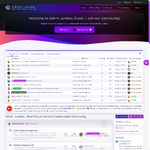San Anderson
New member
The importance of efficiency and consistency applies basically to the world of proprietary trading, or prop trading. One of the important technologies to realize this very efficiently is the trade copier system. Trade copiers duplicate trades from one or more master accounts to any number of slave accounts, ensuring uniformity in strategy implementation and maximization of profits. Hence, this comprehensive guide will help gain deep insights into the trade copier system and explain the relevance and utility for these systems in the context of a prop firm.
What is a Trade Copier System?
It is a software solution that duplicates trades from one trading account to one or several other accounts, referred to as slave accounts. This system therefore guarantees uniformity in the execution of precisely similar trades on all linked accounts, diminishing the effect of human failure.
How Do Trade Copier Systems Work?
In general, trade copier systems are based on monitoring the master account for any trading activity and then replicating these trades in slave accounts. Here is a breakdown of the process in steps:
Signal Generation: In the master account, trading signals are generated according to the trader's strategy.
Signal Transmission: These trading signals are then transmitted to the trade copier software.
Order Execution: On the slave accounts, the same trades will be executed by the trade copier software, hence replicating the activity of the master account.
Ongoing Synchronization: A trade copier will continue to monitor the master account for any changes—for instance, Stop Loss adjustments or closure of the trade—to have an identical copy in the slave accounts.
Key Features of Trade Copier Systems
Multiple key features should be viewed when choosing a trade copier system for your prop firm. This includes the following—
Speed and Reliability: The speed and reliability with which it executes trades should be assured to avoid any differences between the master and slave accounts.
Personalization: It should provide the possibility of personalization in parameters like trade size, risk management settings, and instruments to be copied.
Compatibility: The system should be compatible with multiple trading platforms and brokers.
Security: Security in respect of trade data and account information is of the highest order.
Scalability: It should be able to support a large number of slave accounts without performance degradation.
It provides full monitoring and reporting tools to track performance and highlight any issues.
Advantages of Trade Copier Systems to Prop Firms
Some of the primary advantages of trade copier systems to prop firms include the following:
Consistency: It ensures consistency in trading strategies across all accounts, thus averting human errors.
Efficiency: It saves much time and effort by automating the replication process of trades.
It provides scalability for prop firms through running multiple accounts with ease.
Risk Management: With consistency of trade execution and following predefined risk parameters, it has a better risk management system.
Performance Monitoring: Multiple account tools to monitor and analyze trading performance across all accounts.
Types of Trade Copier Systems
There are several types of trade copier systems available, each with its associated advantages:
Local Trade Copiers: These run on the same machine or local network, offering fast execution but limited only to accounts on the same trading platform.
Remote Trade Copiers: Function across different machines and across different networks; thus, one can be assured of wide compatibility with most brokers and platforms.
Cloud-Based Trade Copiers: They are developed to take advantage of cloud technology in order to offer high scalability and flexibility for the smooth copying of trades across diverse locations.
Setting Up a Trade Copier System for a Prop Firm
Setting up the trade copier system would involve the following steps:
Selection of Appropriate Software: An appropriate trade copier system would be selected which meets all the requirements of the firm with respect to its compatibility, features, and price.
Configuration of Master Account: Renowned setup of the master account with the trading strategy to be replicated across the slave accounts. Link all slave accounts to the trade copier system; ensure that all permissions and settings are properly configured.
System Testing: The system should be comprehensively tested to ensure that trades are accurately and efficiently copied.
Monitoring and Maintenance: Run the system in a continuous cycle of problem identification and solution, coupled with regular maintenance.
Challenges and Considerations
Though trade copier systems have a lot to offer in terms of benefits, there are also some challenges and considerations that need to be taken into account, including the following:
Latency: Remote or cloud-based systems might suffer from delays in the execution of trades. Choosing a low-latency system is very critical.
Broker Limitations: Some brokers may have restrictions on copying of trades. Thus, it is important to check for the same.
Cost: High-quality trade copiers could be really expensive; therefore, firms need to balance cost against the benefits realized.
Security: In a trade, the data of trade and the account details are of the highest importance. A system with strong security measures has to be opted for.
Technical Expertise: The setting up and maintenance of a trade copier requires technical expertise. This may require investment in training by firms or hiring of specialized personnel.
Best Practices of Using Trade Copier Systems
Prop firms looking for the best advantages from trade copier systems should do their operation in the following best practices:
System Monitoring: The system should be read regularly to ensure that trades are properly copied and problems are detected in a timely manner.
Risk Controls: Effective risk control measures should be in place to prevent large losses.
System Redundancy: Consider running backup systems to ensure continuity in case of technical failure.
Training: There should be ongoing training for traders and technical staff on how to use the trade copier system.
Performance Analysis: The trading performance shall be regularly analyzed to improve and optimize trading strategies.
Conclusion
Trade copier systems are very instrumental tools for prop firms looking to gain consistency, efficiency, and scalability. It is through the understanding of how the systems work, selecting appropriate software, and best practices that trade copier technology can help a prop firm in developing their trading operations to realize more success. Understanding new developments regarding trade copier technology will become imperative for any firm intending to keep up as the trading landscape changes day in and day out.
What is a Trade Copier System?
It is a software solution that duplicates trades from one trading account to one or several other accounts, referred to as slave accounts. This system therefore guarantees uniformity in the execution of precisely similar trades on all linked accounts, diminishing the effect of human failure.
How Do Trade Copier Systems Work?
In general, trade copier systems are based on monitoring the master account for any trading activity and then replicating these trades in slave accounts. Here is a breakdown of the process in steps:
Signal Generation: In the master account, trading signals are generated according to the trader's strategy.
Signal Transmission: These trading signals are then transmitted to the trade copier software.
Order Execution: On the slave accounts, the same trades will be executed by the trade copier software, hence replicating the activity of the master account.
Ongoing Synchronization: A trade copier will continue to monitor the master account for any changes—for instance, Stop Loss adjustments or closure of the trade—to have an identical copy in the slave accounts.
Key Features of Trade Copier Systems
Multiple key features should be viewed when choosing a trade copier system for your prop firm. This includes the following—
Speed and Reliability: The speed and reliability with which it executes trades should be assured to avoid any differences between the master and slave accounts.
Personalization: It should provide the possibility of personalization in parameters like trade size, risk management settings, and instruments to be copied.
Compatibility: The system should be compatible with multiple trading platforms and brokers.
Security: Security in respect of trade data and account information is of the highest order.
Scalability: It should be able to support a large number of slave accounts without performance degradation.
It provides full monitoring and reporting tools to track performance and highlight any issues.
Advantages of Trade Copier Systems to Prop Firms
Some of the primary advantages of trade copier systems to prop firms include the following:
Consistency: It ensures consistency in trading strategies across all accounts, thus averting human errors.
Efficiency: It saves much time and effort by automating the replication process of trades.
It provides scalability for prop firms through running multiple accounts with ease.
Risk Management: With consistency of trade execution and following predefined risk parameters, it has a better risk management system.
Performance Monitoring: Multiple account tools to monitor and analyze trading performance across all accounts.
Types of Trade Copier Systems
There are several types of trade copier systems available, each with its associated advantages:
Local Trade Copiers: These run on the same machine or local network, offering fast execution but limited only to accounts on the same trading platform.
Remote Trade Copiers: Function across different machines and across different networks; thus, one can be assured of wide compatibility with most brokers and platforms.
Cloud-Based Trade Copiers: They are developed to take advantage of cloud technology in order to offer high scalability and flexibility for the smooth copying of trades across diverse locations.
Setting Up a Trade Copier System for a Prop Firm
Setting up the trade copier system would involve the following steps:
Selection of Appropriate Software: An appropriate trade copier system would be selected which meets all the requirements of the firm with respect to its compatibility, features, and price.
Configuration of Master Account: Renowned setup of the master account with the trading strategy to be replicated across the slave accounts. Link all slave accounts to the trade copier system; ensure that all permissions and settings are properly configured.
System Testing: The system should be comprehensively tested to ensure that trades are accurately and efficiently copied.
Monitoring and Maintenance: Run the system in a continuous cycle of problem identification and solution, coupled with regular maintenance.
Challenges and Considerations
Though trade copier systems have a lot to offer in terms of benefits, there are also some challenges and considerations that need to be taken into account, including the following:
Latency: Remote or cloud-based systems might suffer from delays in the execution of trades. Choosing a low-latency system is very critical.
Broker Limitations: Some brokers may have restrictions on copying of trades. Thus, it is important to check for the same.
Cost: High-quality trade copiers could be really expensive; therefore, firms need to balance cost against the benefits realized.
Security: In a trade, the data of trade and the account details are of the highest importance. A system with strong security measures has to be opted for.
Technical Expertise: The setting up and maintenance of a trade copier requires technical expertise. This may require investment in training by firms or hiring of specialized personnel.
Best Practices of Using Trade Copier Systems
Prop firms looking for the best advantages from trade copier systems should do their operation in the following best practices:
System Monitoring: The system should be read regularly to ensure that trades are properly copied and problems are detected in a timely manner.
Risk Controls: Effective risk control measures should be in place to prevent large losses.
System Redundancy: Consider running backup systems to ensure continuity in case of technical failure.
Training: There should be ongoing training for traders and technical staff on how to use the trade copier system.
Performance Analysis: The trading performance shall be regularly analyzed to improve and optimize trading strategies.
Conclusion
Trade copier systems are very instrumental tools for prop firms looking to gain consistency, efficiency, and scalability. It is through the understanding of how the systems work, selecting appropriate software, and best practices that trade copier technology can help a prop firm in developing their trading operations to realize more success. Understanding new developments regarding trade copier technology will become imperative for any firm intending to keep up as the trading landscape changes day in and day out.



